Integrating Technology
Genetics with Dragons
Using an online learning environment to help students achieve a multilevel understanding of genetics
By Kiley McElroy-Brown, Frieda Reichsman
Hardware, software, and websites for use in the classroom.
Genetics, a core topic of biology in both middle and high school, is difficult to teach and learn (Duncan et al. 2009; Tsui and Treagust 2010). This is in part because genetic phenomena span multiple organizational levels, many of which are invisible (e.g., cells, molecules) and arise from the behavior of entities unfamiliar to students (e.g., genes, proteins). In addition, the notion that genetic information merely specifies the structure (and consequently the function) of proteins is rather counterintuitive to children (Lewis and Kattmann 2004). However, knowing that genes provide instructions for making proteins and that proteins have many functions that ultimately give rise to physical traits is a powerful and generative understanding that can explain a plethora of genetic phenomena (Allchin 2002).
Current instructional practices tend to gloss over the causal mechanisms that link genes to traits (Duncan, Rogat, and Yarden 2009; Pavlova and Kreher 2013) in favor of an approach focused on patterns of correlations between genes and traits, namely dominant and recessive inheritance. In contrast, A Framework for K–12 Science Education (NRC 2012) and the Next Generation Science Standards (NGSS Lead States 2013) place new emphasis—starting in middle school life science—on the central role of proteins in bringing about traits.
The Concord Consortium and our collaborators have developed a free digital genetics game, Geniventure, with an engaging narrative featuring dragons that need to be saved from extinction and highlighting the role of proteins in genetics. Geniventure runs on any modern web browser; it also runs on iPads, Chromebooks, and other tablets. Geniventure leverages our popular Geniverse software that has been used in classrooms by nearly 150,000 students over the last eight years, with approximately one-third of them being middle school students. We redesigned the original Geniverse to enhance learning by this younger audience and to include the multilevel components responsible for physical traits. Through scaffolded virtual investigations, students first explore the physical traits that result from allele combinations, then dive deeper by zooming into cells and manipulating the proteins that ultimately give rise to those traits.
The real genes behind the dragons
Scientists learn from model species and apply what they have learned to a target species (e.g., the mouse is a model species for human genetic disease). In Geniventure, small dragon-like organisms called drakes serve as the model organism for dragons. There is real biology behind the drake genes and traits, which have been carefully compiled from the actual genes and associated traits of the anole lizard, mouse, fruit fly, zebrafish, and other model species. The genes that affect drake traits, such as wing development and skin color, are genes that are involved in the development of those traits in real organisms.
For example, the albino gene is modeled after the anole lizard gene for tyrosinase, the central enzyme in the pathway for making the pigment melanin. The recessive allele results in a misshapen and inactive enzyme, causing a malfunction in protein binding and catalytic activity. Thus, in a homozygous recessive drake, there is an absence of pigment (melanin) in cells. Drakes that are homozygous for the recessive albino allele (c/c) have scales that are translucent white, completely lacking pigment (Figure 1). Just like albinism in humans, the albino phenotype masks the phenotypes of other scale-color genes. There is no difference in appearance of albino drakes carrying any combination of alleles for shiny, gray, or deep color.
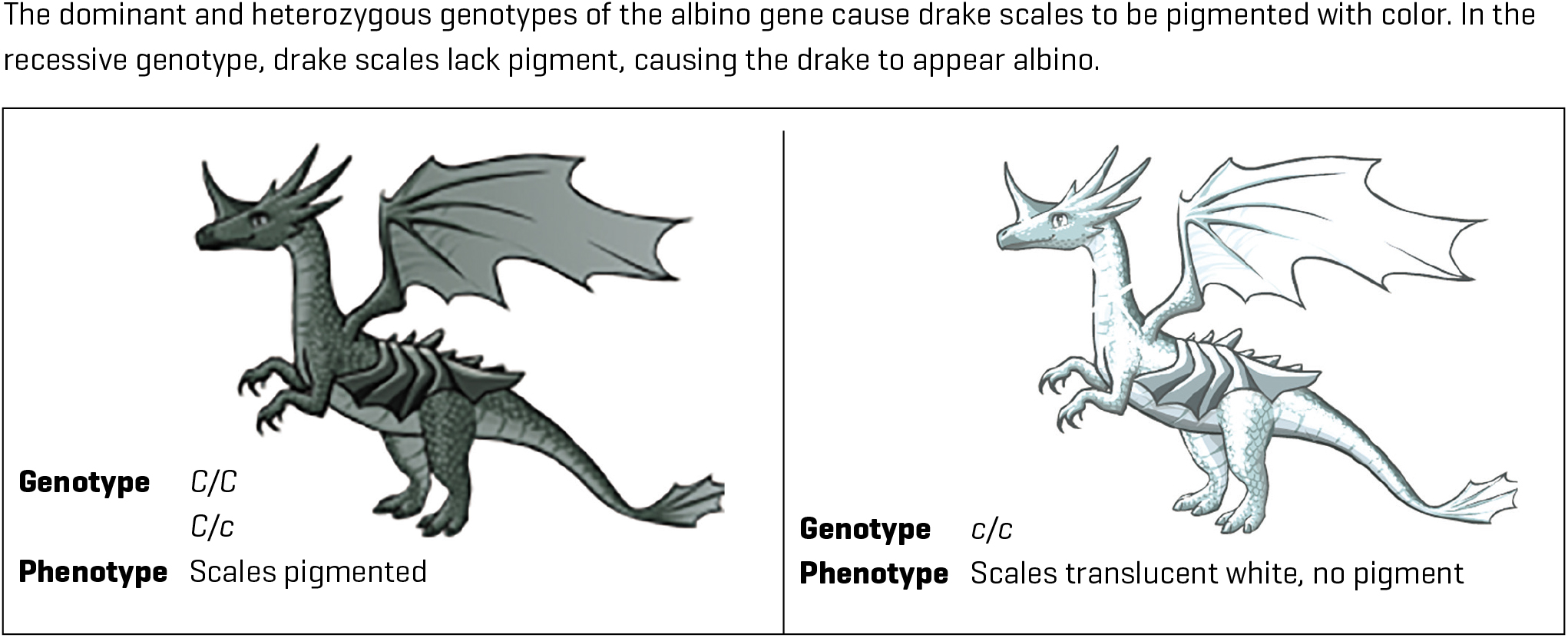
Connecting genes, cells, and proteins
Engage
Students begin their adventure in Mission Control, where they are greeted by Professor Hatch and Dr. Weaver, the leaders of the Drake Breeder’s Guild. Their country is under attack and dragons are in danger of going extinct. Students join an elite team of scientists who are working to bring dragons back from the brink. Engaged by the fantasy setting of Geniventure, students are motivated by the need to save the dragons.
Explore and explain: Levels 1 and 2: Mendelian genetics (approximately 90 minutes)
Students launch into gameplay by experimenting with allele combinations (genotypes) that give rise to certain traits (phenotypes) in drakes (Figure 2). By using pull-down menus to change alleles on pairs of chromosomes and by inspecting and sorting eggs based on their genotypes (Figure 3), students explore the difference between dominant and recessive traits, including the concept of incomplete dominance.
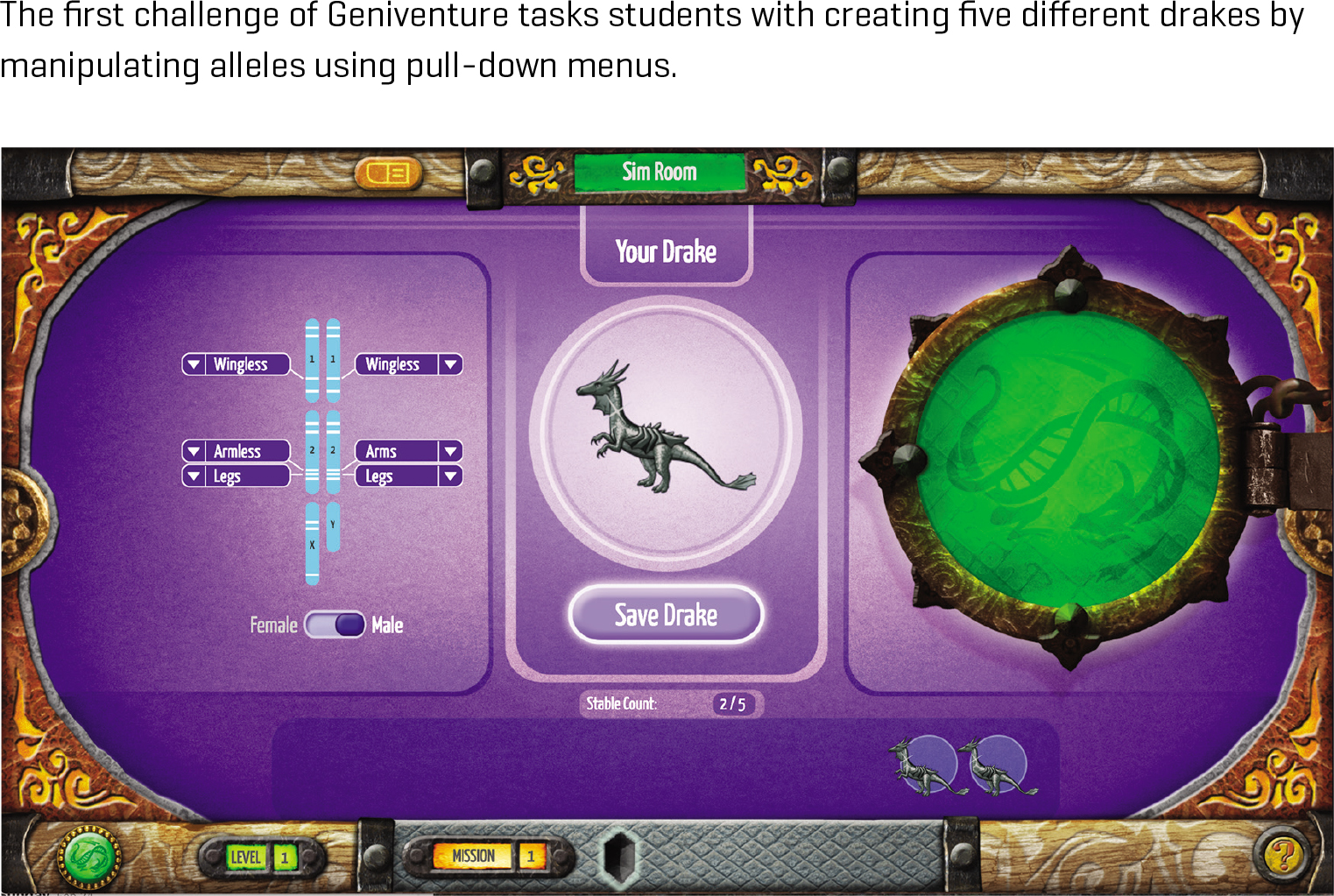
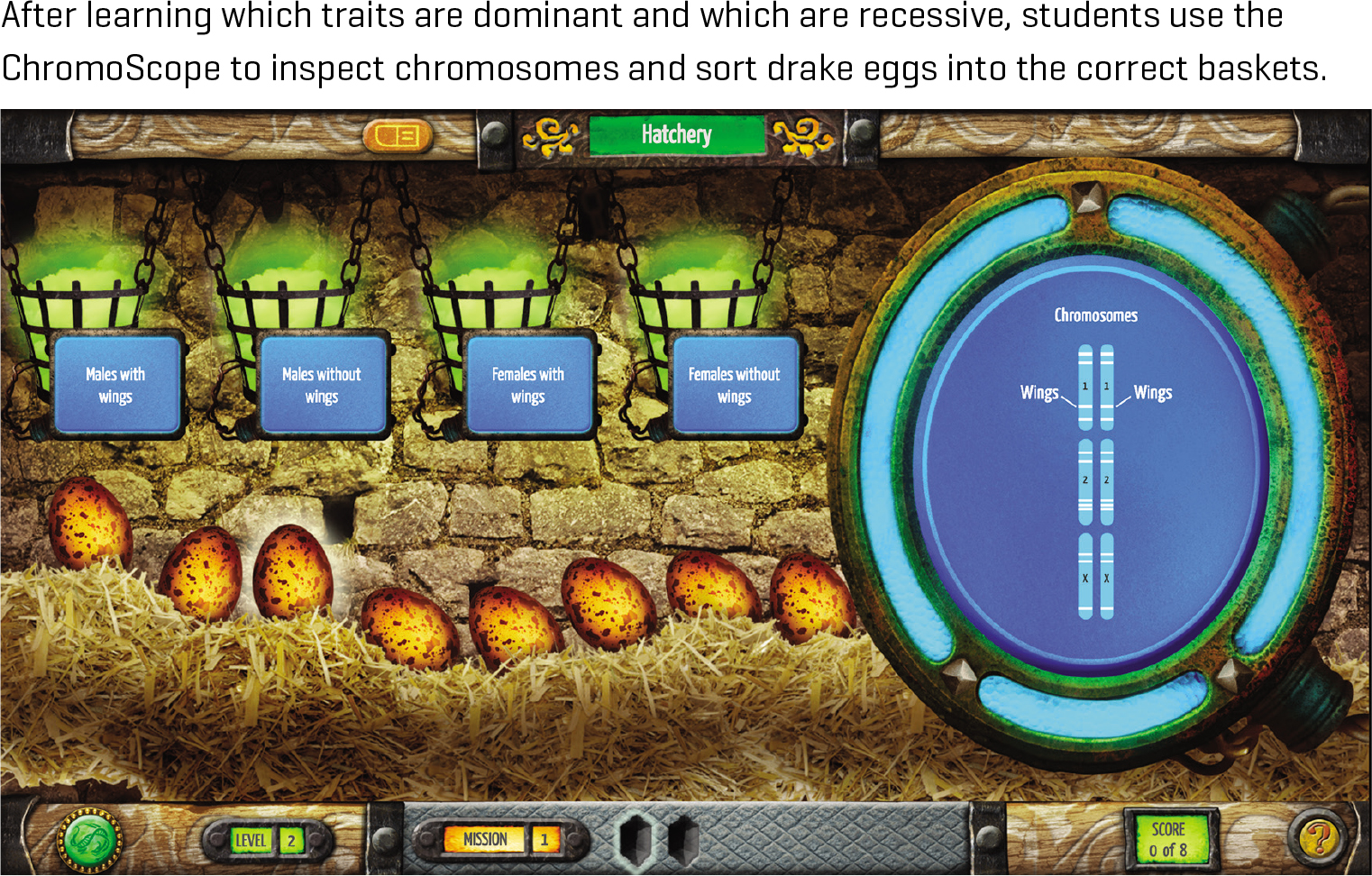
The interactive models that students use to conduct virtual experiments in Geniventure are powered by genetics programming that accurately simulates real-life patterns of inheritance in humans and model organisms. Students are thus learning to analyze experimental results that would be obtained from these genes in a laboratory.
Elaborate: Level 3: Gene to protein to trait relationship (approximately 120 minutes)
In level 3, students are introduced to three genes that each control a facet of drake scale color. Each gene’s alleles influence the melanin pathway in skin cells; the alleles of the gray gene influence drake color to be either gray or orange, the recessive alleles of the color gene result in an albino drake, and the shiny gene leads to either a shiny or dull “finish” on the scale color.
To begin, students zoom into a cell-level view of the process of producing scale color (modeled after real-world melanin production in skin, hair, and fur) (Figure 4). By clicking on either the Golgi apparatus or the “tunnels” between the cells, students zoom even further into a melanosome (a cellular “capsule” of melanin) to watch the tyrosinase, TYRP1, and ASIP proteins at work.
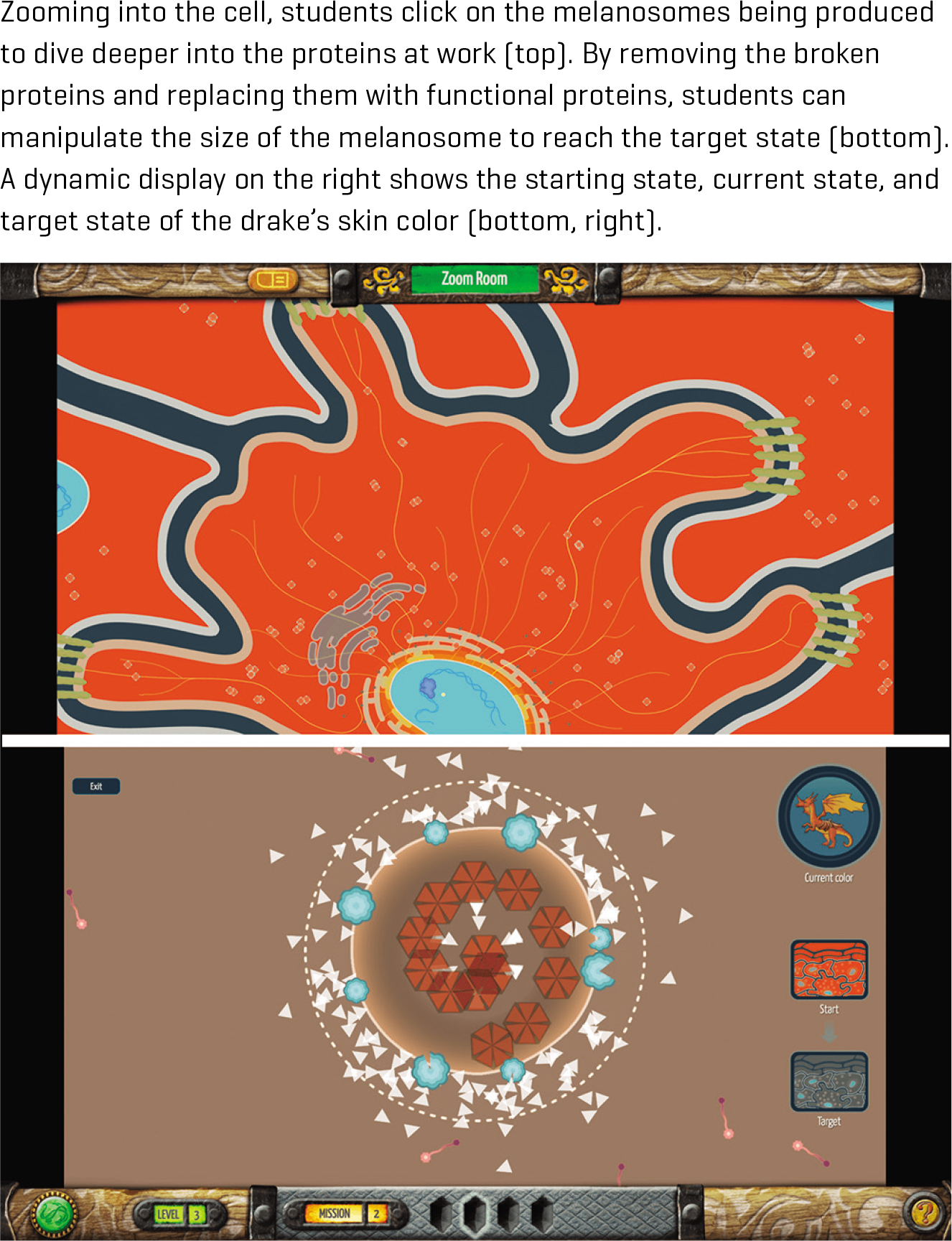
Several missions and challenges in level 3 task students with changing the color of the drake’s scales by helping or hindering the proteins, which in turn speeds up or slows down melanin production. Making a melanosome larger or smaller produces gray- or orange-colored drakes and closing or opening the gates to the scale cells produces shiny or dull drakes (Figure 4).
Each gene can code for two versions of each protein: functional and nonfunctional. Depending on the genotype of the starting drake, students see a combination of functional and nonfunctional proteins and use their knowledge of their functions to manipulate the proteins and achieve the target state.
Level 3 also gives students an opportunity to apply their knowledge of dominant and recessive inheritance and extend it to the DNA level. After successfully interacting with the proteins to win challenges, students “level up” to enter the nucleus and make a permanent change to the DNA.
Making this protein-based link from DNA to trait is critical for students’ ability to make sense of the patterns between genes and traits and to apply the same logic to other genetic phenomena. We have observed the “aha” moment when middle school students suddenly see that the fate of melanosomes is a function of the proteins that work—or don’t—to make and transport melanin, and that having just one functional protein is enough to get the job done (explaining the phenomenon of dominance).
Level 4: Transmission genetics (approximately 40 minutes)
Students proceed from their understanding of how genes confer traits (via proteins in cells) to how alleles are inherited from parent to offspring (via gametes and fertilization). Level 4 begins with a highly scaffolded focus on generating gametes to support student understanding of the heredity of parents’ alleles as opposed to the parents’ traits. With the goal of producing an offspring drake with prespecified traits (a “target drake”), students simulate meiosis by selecting chromosomes from each parent to create their gametes (Figure 5). Geniventure then animates fertilization with the joining of sperm and egg cells, producing a drake with a full set of alleles for each gene. Once students match the target, they observe gametes generated by animated random assortment of chromosomes and select from among them. Students ultimately create clutches of target drakes from crosses—by setting the alleles of the parents to favor the random generation of gametes that can come together by chance to create the target drake.
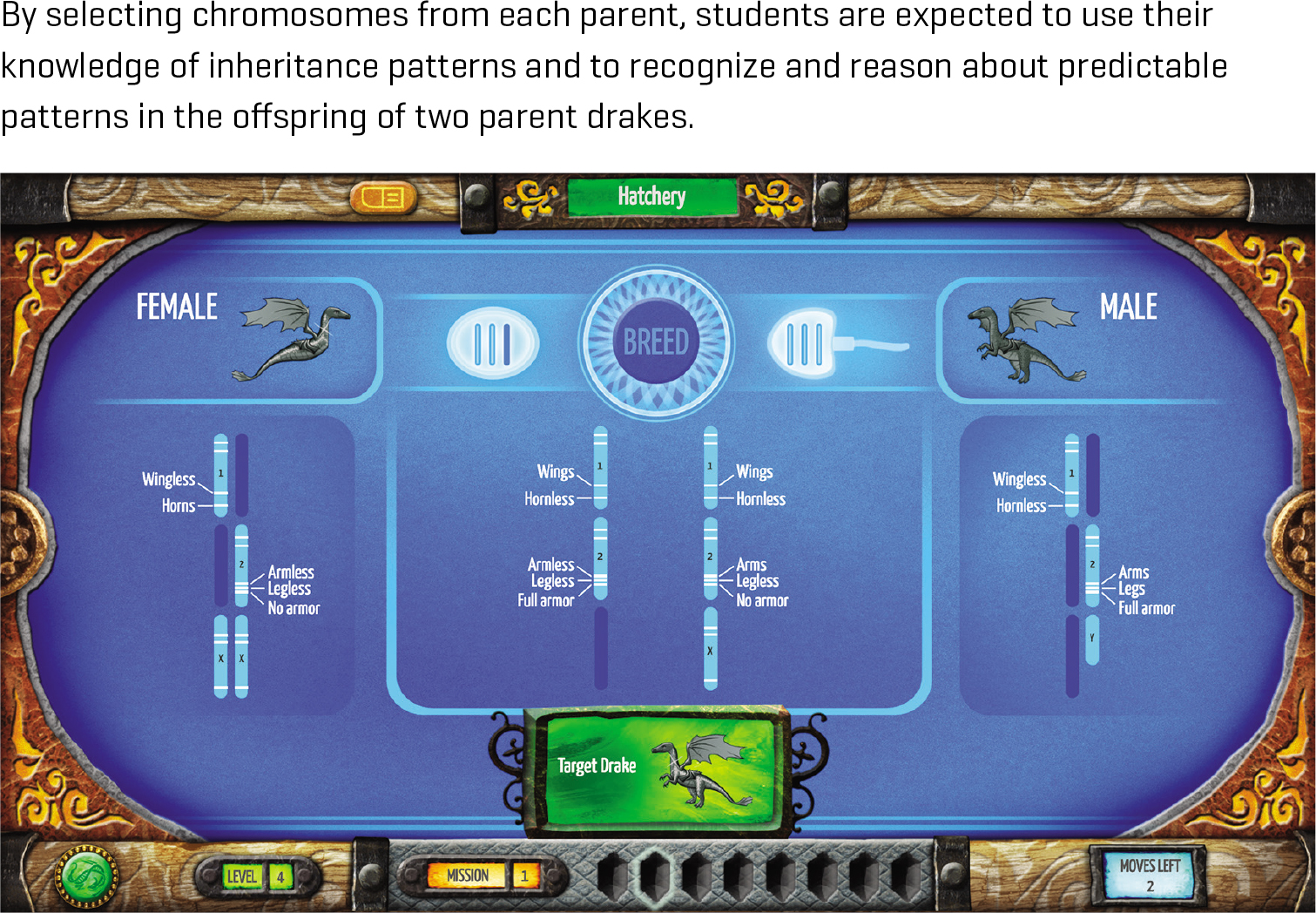
Level 5: Test cross (approximately 15 minutes)
A classic tool in genetics is the test cross—uncovering a genotype by breeding against an organism with recessive traits—and level 5 scaffolds students toward understanding and using this process. Students are faced with a drake that has multiple dominant phenotypes, and therefore indeterminate genotypes. Students must set alleles to breed a recessive drake and determine the unknown genotype of the mystery drake (Figure 6). Students integrate their understanding of how alleles are inherited with their knowledge of relevant genotype–phenotype relationships.
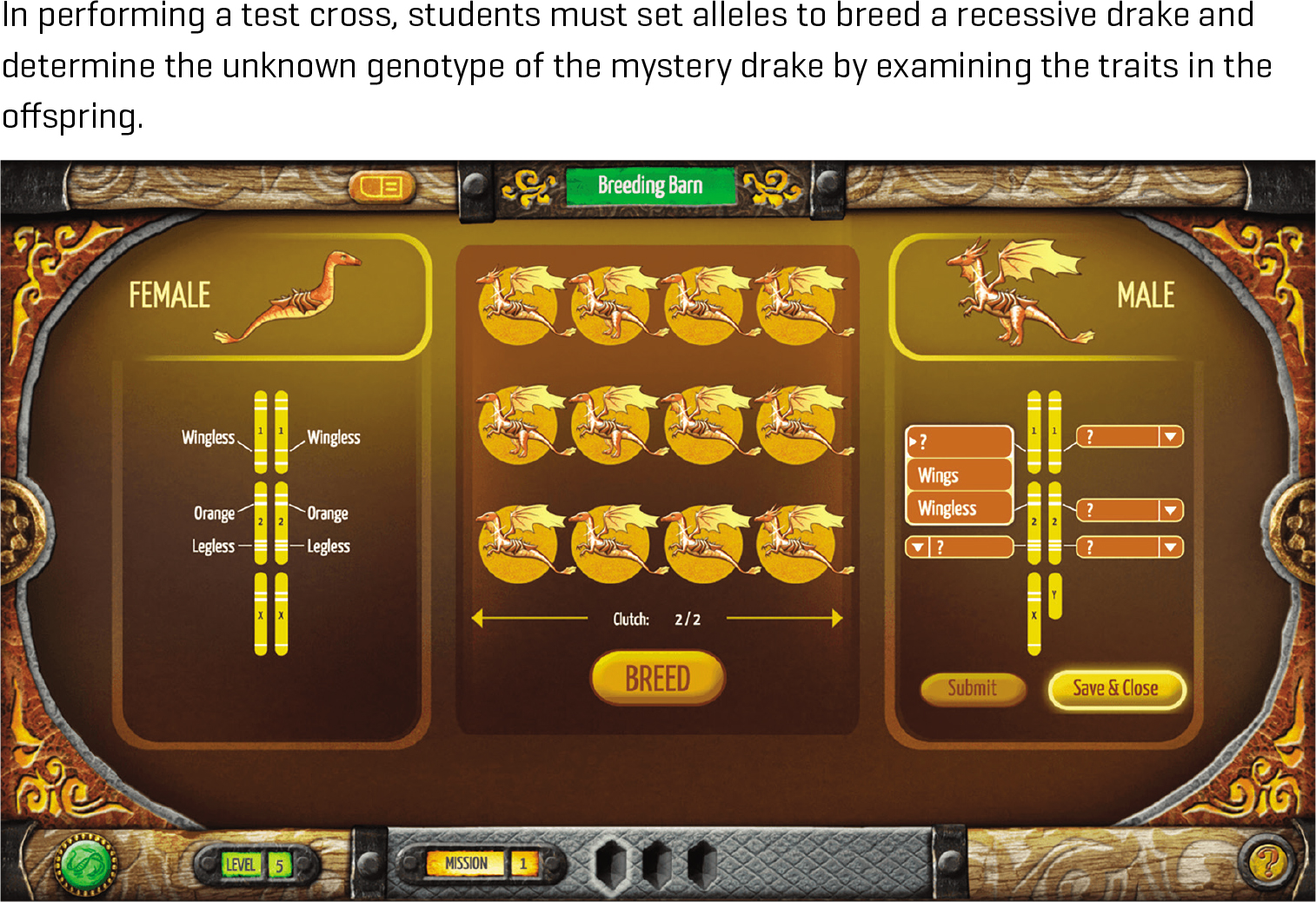
Level 6: Polyallelic and X-linked traits (approximately 45 minutes)
Additional drake traits with more complex modes of inheritance are the focus of level 6. Students work with a trait that has three alleles, and with two genes found on the × chromosome. The familiar interfaces for changing alleles, sorting eggs, creating gametes, breeding, and performing test crosses enable students to explore and puzzle out mechanisms of non-Mendelian inheritance, bringing these more advanced topics within reach for many middle school students.
Evaluate: VentureMap
Students are evaluated throughout Geniventure. The VentureMap displays the number of crystals a student has earned for each level (Figure 7). The color of the crystal indicates a student’s performance on each challenge. A red crystal suggests that a student did not perform well in that challenge, a yellow crystal indicates only one or two mistakes, a blue crystal shows that the student completed the challenge perfectly, and a black crystal reveals that the student made multiple mistakes and must retry that challenge before advancing to the next mission.
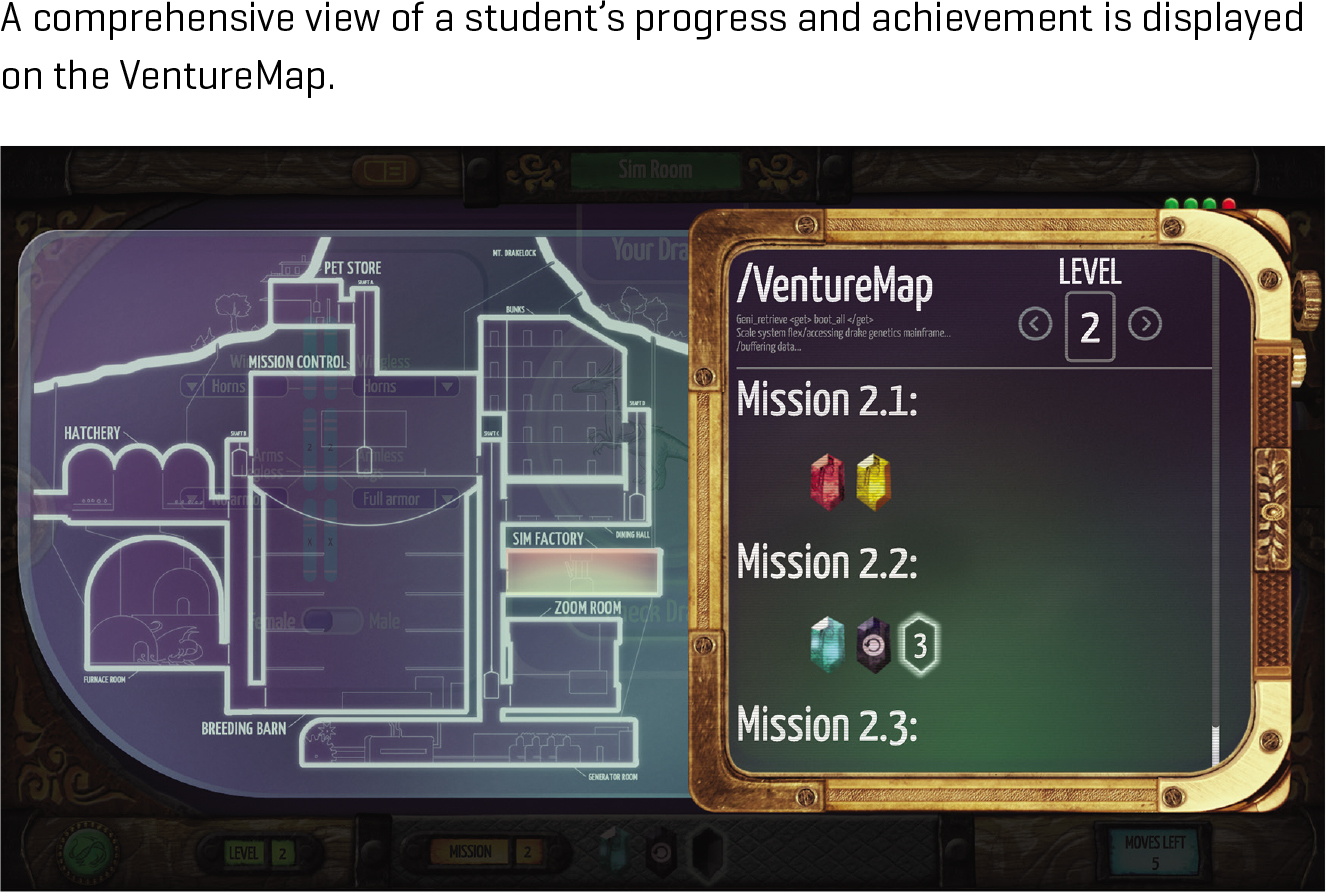
Intelligent tutoring system and teacher dashboard
Geniventure is designed to be used in classrooms, with guidance and reflection facilitated by a teacher. Geniventure includes an Intelligent Tutoring System (ITS) that tracks students’ actions as they play, with each action tied to one or more specific genetics concepts. The ITS provides students with real-time visual feedback and text-based hints targeting the specific concepts the student may be having trouble with. At the same time, the ITS relays the relevant information to a teacher dashboard. If a student makes a mistake on the same concept multiple times, the ITS will prompt the student to complete a focused, remedial “bonus” challenge for additional practice. Teachers can then facilitate strategic guidance of student learning by accessing the information provided by the ITS on the teacher dashboard. In addition, a comprehensive teacher’s guide for Geniventure, including printable Geniventure worksheets and guided discussion questions, will be available to the public in August 2019 (see Resource).
Using the data from the ITS and student crystals, the Geniventure teacher dashboard offers teachers real-time data on each student’s progress and performance. Aggregated learning patterns across student models help teachers identify issues of concern for the entire class. Teachers can act on these data in a variety of ways, supporting individual students, grouping or regrouping students based on either strong or weak performance on certain challenges or concepts, or identifying opportunities for wholeclass intervention, such as guided discussion or other off-computer sense-making activities.
Classroom management
In Geniventure, students are encouraged to work individually. However, paired gameplay is also suitable if computers are limited or if a teacher prefers to group students for pedagogical reasons or classroom norms. Although Geniventure includes subtle sound effects, most students do not find them to be disruptive, and the volume on computers can be turned off to mitigate any noise control issues. Importantly, Geniventure offers flexibility for students who work at different speeds to complete the challenges. When the ITS detects that a student is struggling, the game presents hints that include both text and visual clues or “bonus” challenges. Because all student work is sent to the dashboard, teachers can monitor the number of student attempts per challenge and see which students were directed to bonus challenges. Students who complete challenges early are encouraged to repeat them to earn higher-level crystals. Because the game is online and accessible from any modern web browser on desktop computers and tablets, students who are absent from class may complete assignments as homework or during out-of-school time.
Conclusion
The NGSS encourage middle school students to dive deeper into understanding the role of proteins in bringing about traits. We developed software that middle school students find engaging and that allows them to experiment with the multiple levels of genetics—from genes to proteins to traits—helping prepare them for high school biology. Geniventure offers an environment for young learners to interact with a multilevel model that illustrates scale, conceptualizes the structure-and-function relationship, and emphasizes coherence across concepts that are often challenging for teachers to convey with traditional instruction.


